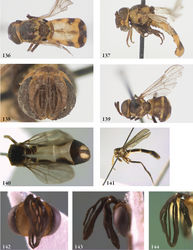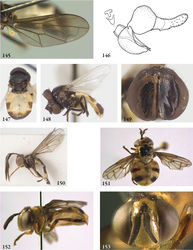Masarygus palmipalpus
| Notice: | This page is derived from the original publication listed below, whose author(s) should always be credited. Further contributors may edit and improve the content of this page and, consequently, need to be credited as well (see page history). Any assessment of factual correctness requires a careful review of the original article as well as of subsequent contributions.
If you are uncertain whether your planned contribution is correct or not, we suggest that you use the associated discussion page instead of editing the page directly. This page should be cited as follows (rationale):
Citation formats to copy and paste
BibTeX: @article{Reemer2013ZooKeys288, RIS/ Endnote: TY - JOUR Wikipedia/ Citizendium: <ref name="Reemer2013ZooKeys288">{{Citation See also the citation download page at the journal. |
Ordo: Diptera
Familia: Syrphidae
Genus: Masarygus
Name
Masarygus palmipalpus Reemer sp. n. – Wikispecies link – ZooBank link – Pensoft Profile
Type specimens
HOLOTYPE. Adult male. PERU. Label 1: “PERU. Madre de Dios, Rio / Tambopata, Sachavacayoc Centre / 12°51'S–69°22'W. Mal. trap / 28–30.X.2008. Leg. J.T. Smit”. Coll. RMNH (preliminary deposition, to be transferred to relevant Peruvian collection later).
Diagnosis
This is the only known species of Microdontinae in which the antenna of the male is furcate into five branches.
Description (based on holotype)
Adult male. Body size: 4 mm.
Head. Head unusually flat. Face wide: occupying about 3/4 of head width in frontal view; somewhat concave laterally; yellow; yellow pilose, except black pilose laterally on dorsal 1/2. Gena yellow; yellow pilose. Oral margin not produced; oral opening barely visible; mouth parts undeveloped. Frons brown; black pilose; very short; distance between frontal ocellus and antennal fossa shorter than height of antennal fossa. Vertex blackish brown medially, yellow laterally; black pilose; ocelli arranged almost in a straight line, with frontal ocellus weakly developed, much smaller than the other two. Occiput yellow; black pilose dorsally, yellow pilose ventrally. Eye bare. Antennal fossa about 1,5 times as wide as high. Antenna black; black pilose; ratio of scape:basoflagellomere approximately as 1:8; pedicel very short. Basoflagellomere furcate into five branches, four of which about equally long, the fifth branches off from one of the other at about ¼ from the base of the segment, with a length of about 2/5 of the other branches. Arista absent.
Thorax. Mesoscutum black, except narrowly pale yellow along margins; black pilose. Postpronotum pale yellow; bare. Postalar callus pale yellow; black pilose. Scutellum black; black pilose; semicircular; without calcars; flat, appearing even slightly concave; smooth and shining along margins, dull dorsally due to micropunctation; black pilose. Anepisternum pale yellow along dorsal margin, brown otherwise; with sparse long black pile, also ventrally; without sulcus. Other pleurae yellowish to brown; bare (also without microtrichia). Calypter pale yellow. Halter pale yellow with greyish margin.
Wing: Hyaline; microtrichose, except bare on cell sc and basal 1/4 of cell cup.
Legs: Front and mid leg pale yellow, except dark brown on basal 3/4; black pilose. Hind leg dark brown, except fifth tarsomere yellow; black pilose. Front coxa exceptionally long: about 4/5 of length of femur, longer than tibia; pale brown; bare. Other coxae and trochanters shorter; pale brown; very sparsely black pilose.
Abdomen. Strongly flattened dorsoventrally. Tergite 1 blackish; black pilose; medially interrupted by the whitish antetergite, which is almost entirely fused with the tergite. Tergites 2 and 3 whitish, except black on lateral 1/5, the black part most narrow at posterior margin; black pilose. Tergite 4 black, except for a pair of whitish, submedian, oval maculae at posterior 1/2. Sternite 1 whitish; bare. Sternite 2 whitish; yellow pilose. Sternite 3 whitish, except for lateral dark brown, round macula at anterior 1/2, of about 1/4 of tergite width; yellow pilose, except black pilose anteromedially. Sternite 4 whitish, except for pair of dark brown, oval maculae, almost confluent medially; black pilose anteriorly, yellow pilose posteriorly. Male genitalia as in Fig. 146.
Female. Unknown.
Etymology
The specific epithet (noun in apposition) is composed of the Latin words palma (hand) and palpus (feeler, here interpreted as antenna). The name refers to the hand-like antenna of the male of this species.
Original Description
- Reemer, M; Ståhls, G; 2013: Generic revision and species classification of the Microdontinae (Diptera, Syrphidae) ZooKeys, 288: 1-213. doi
Images
|

